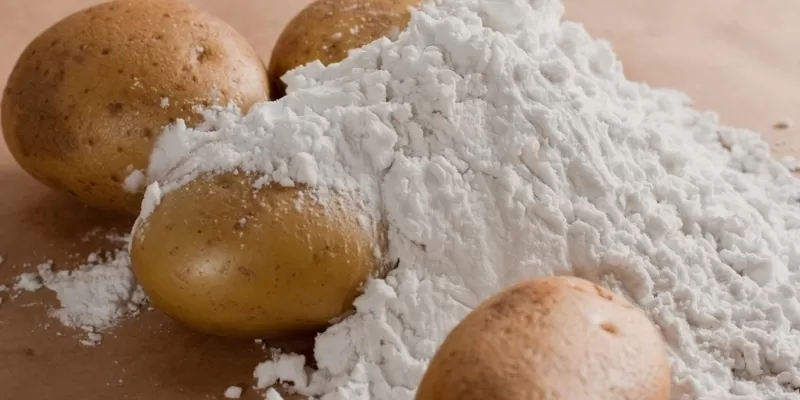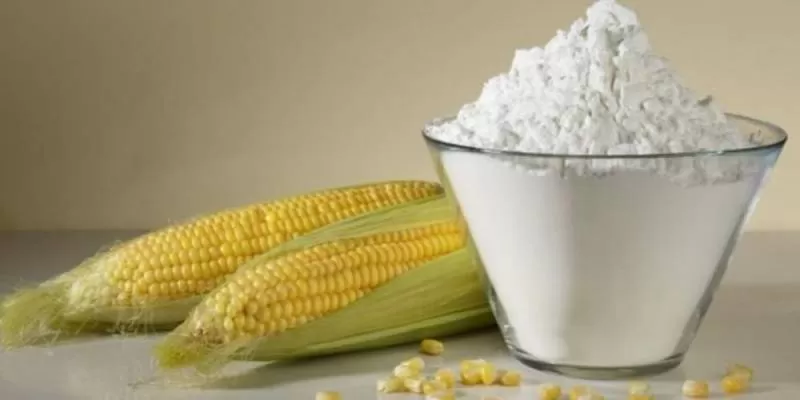Starch is different. Of course, since Soviet times, most housewives have been accustomed to only one variety of this ingredient — potato — but now you can easily find more exotic options on store shelves. For example, corn. And despite the fact that these varieties are very similar in chemical composition, they have extremely different effects.
Let’s figure out how potato starch differs from corn starch and what is better to use in cooking.
Potato starch

Potato starch is one of the most common ingredients in the so-called “home cooking”. It is actively added to kissels, sauces, pastries, creams and other products. It thickens quickly and forms pastes with almost any liquid.
The main characteristics of potato starch are:
-
Fine crystalline form. The powder characteristically “crunches” (like snow on a frosty day) when rubbed between fingers or squeezed;
-
High viscosity. The pastes it creates can be so viscous that they won’t even drip off a spoon. Using this starch in large quantities, you can prepare jelly, which will be similar in texture to jelly based on gelatin or agar-agar;
-
High transparency. Diluted powder does not change the color of water or fruit juice when it forms a paste with them. That is why it is perfect for use as a thickener in dishes such as jelly and sauces;
-
Characteristic aftertaste. This ingredient has a slightly pronounced, but still noticeable aftertaste. This is important to consider when preparing dishes from it.
Being a thickening agent that also clumps when heated above boiling point, this ingredient is rarely used in baking biscuit or pastry. But for sand, it fits perfectly. Such pastries become more crumbly and less rigid.
However, when preparing sauces, glazes or, for example, jelly, it is very important not to overheat it. Then the texture is irreversibly destroyed — and the finished dish becomes too liquid or unpleasantly “rubber”.
So, let’s sum up.
Advantages
-
Excellent thickener, forms pastes with high viscosity and even elasticity;
-
Forms transparent solutions, due to which it is suitable for the preparation of slightly colored dishes (for example, apricot jelly);
-
It is difficult to confuse with flour, as it has a characteristic microcrystalline texture.
Flaws
- It has a slightly pronounced, but characteristic and noticeable aftertaste in dishes.
In addition, potato starch contains gluten. This is important to consider for people who follow a gluten-free diet. It also slightly changes the composition and texture of the product — it becomes more “heavy”, so dishes with an airy texture based on this ingredient cannot be prepared.
Corn starch

Corn starch, unlike its potato counterpart, does not contain gluten. Therefore, it is suitable for consumption on a gluten-free diet. However, at the same time, its qualities as a thickener can “suffer” a little.
Indeed, cornstarch is not a very good thickener. You can’t even cook jelly on it — the dish will turn out to be viscous, but liquid. But it is well suited for some creams, sauces and soups in which it is not necessary to achieve increased viscosity. In addition, this ingredient is widely used in baking — it makes biscuit and pastry dough more airy.
The main characteristics of cornstarch are:
-
Powder form. As a result, it becomes indistinguishable from flour either in appearance or texture in its dry form. This is very important to take into account during storage, so as not to accidentally confuse the two ingredients;
-
Low viscosity. Pastes based on it retain a liquid form and begin to resemble egg white in texture. When heated, they significantly increase in size, become elastic, but crumple very much;
-
Low transparency. Pastes based on this product become similar to diluted milk. It is also important to take this into account when preparing dishes, especially jelly made from light or slightly coloring fruits like apricots;
-
Tasteless. As an ingredient, this powder does not have any taste, so it is not felt in the finished dish.
At home, cornstarch is commonly used in baking. It is added to biscuit and pastry doughs to create a lighter, airy texture. It is also used in the preparation of some creams, especially custards.
So, let’s sum up.
Advantages
-
Gluten-free, making it lightweight and suitable for some types of diets;
-
It does not have its own taste, therefore it can be used in dishes with a delicate and complex flavor bouquet;
-
Excellent for use in biscuits and rich pastries as it provides a light and airy texture without the use of leavening agents.
Flaws
-
Not suitable for use as a thickener;
-
Forms opaque solutions:
-
Easily confused with flour.
It is worth considering that it is not suitable for cooking dishes that involve high-temperature processing (except for baking, of course). It increases in size and crumple when heated.
Waxy corn starch
It is worth mentioning separately another variety of this product, obtained from wax varieties of corn. It differs from the usual chemical composition and a very high content of amylopectin (“binding” carbon).
That is why the paste obtained from it has a harder texture. It is comparable to that prepared from potatoes. However, the inherent stickiness of the corn variant does not disappear.
Usually the variety of corn from which this product is obtained is indicated on the packaging. Powders from wax varieties are usually quite expensive, therefore, in the absence of contraindications to the use of gluten, it is better to replace them with a potato option.
On the other hand, it is used in some types of sports nutrition, because it is an excellent source of complex carbohydrates, but it does not contain lactose, sugar, or similar products. In sports nutrition, it is used to increase the energy of a trainee or athlete, and also promotes muscle recovery.
Comparison
Let’s compare both of these ingredients and determine which one is better.
|
|
|
|
|
|
Excellent
|
Medium
|
|
|
Kissels, sauces, sausages, pastries (shortbread dough), icing
|
Pastries (butter and biscuit dough), creams
|
|
|
Yes, weak
|
Tasteless
|
|
|
Thick, high viscosity
|
Liquid, runny, similar to egg white in texture
|
|
|
Almost transparent
|
Watered milk colors
|
|
|
Yes
|
Not
|
Thus, the main advantage of cornstarch is that it does not contain gluten. But potato has the best qualities as a thickener.
And obtained from wax varieties of corn or wax ripeness, it is used in sports nutrition as a source of carbohydrates.

Добавить комментарий
Для отправки комментария вам необходимо авторизоваться.